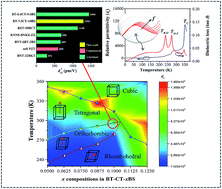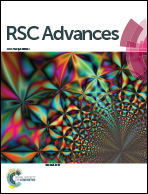High piezoelectric response and polymorphic phase region in the lead-free piezoelectric BaTiO3–CaTiO3–BaSnO3 ternary system
Abstract
This study attempted to replace Pb-based piezoelectric ceramics with a non-toxic lead-free (Ba,Ca)(Ti,Sn)O3 substitute, according to current environmental standards. The design of the (Ba(0.825+x)Ca(0.175−x))(Ti(1−x)Snx)O3 lead-free piezoceramics reported herein was based on chemical modifications by varying Sn concentrations (x = 0.0500–0.1250). The effect of Sn ion modifications on structural evolution and dielectric, ferroelectric and piezoelectric properties was investigated. Partial substitution of Ti with Sn yields a suitable composition with multiphase boundaries near room temperature. As a result, the composition, x = 0.1000, shows outstanding piezoelectric values of d33 = 515 pC N−1 and  = 1293 pm V−1 at 10 kV, which are higher than those found in commercially available soft PZT. Furthermore, anomalous dielectric relaxation is far below the rhombohedral to orthorhombic phase transition at T ≈ 90–150 K, and was found clearly in all compositions. The relaxation fitted the Vogel–Fulcher model with an activation energy of Ea ≈ 20–70 meV and freezing temperature of TVF ≈ 65–85 K.
= 1293 pm V−1 at 10 kV, which are higher than those found in commercially available soft PZT. Furthermore, anomalous dielectric relaxation is far below the rhombohedral to orthorhombic phase transition at T ≈ 90–150 K, and was found clearly in all compositions. The relaxation fitted the Vogel–Fulcher model with an activation energy of Ea ≈ 20–70 meV and freezing temperature of TVF ≈ 65–85 K.



 Please wait while we load your content...
Please wait while we load your content...